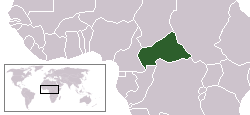Central African Empire
Central African Empire Empire centrafricain | |||||||||
|---|---|---|---|---|---|---|---|---|---|
| 1976–1979 | |||||||||
| Motto: Unité, Dignité, Travail "Unity, Dignity, Work" | |||||||||
| Anthem: La Renaissance "The Renaissance" | |||||||||
 Location of the Central African Empire | |||||||||
| Capital | Bangui | ||||||||
| Common languages | Sango, French | ||||||||
| Religion | Official religions: Protestant, Roman Catholic Minority religion: Sunni Islam | ||||||||
| Government | Absolute monarchy Single-party state | ||||||||
| Emperor | |||||||||
• 1976–1979 | Bokassa I | ||||||||
| Prime Minister | |||||||||
• 1976–1978 | Ange-Félix Patassé | ||||||||
• 1978–1979 | Henri Maïdou | ||||||||
| History | |||||||||
• Established | 04 December 1976 | ||||||||
• Disestablished | 21 September 1979 | ||||||||
| Currency | Central African Franc | ||||||||
| |||||||||
The Central African Empire (French: Empire centrafricain) was the name of the short-lived, self-declared autocratic monarchy that replaced the Central African Republic and was, in turn, replaced by the restoration of the republic. The Empire was formed when Jean-Bédel Bokassa, President of the republic, declared himself Emperor Bokassa I on 4 December 1976. Bokassa spent the equivalent of over 20 million United States dollars, a quarter of the country's government annual income, on his coronation ceremony. The monarchy was abolished and the name "Central African Republic" was restored on 21 September 1979, when Bokassa was ousted with French support.
Proclamation of the Empire

In September 1976, Bokassa dissolved the government and replaced it with the Conseil de la Révolution Centrafricaine 'Central African Revolutionary Council'. On 4 December 1976, at the MESAN congress, Bokassa instituted a new constitution and declared the republic a monarchy, the Central African Empire. He issued an imperial constitution, announced his conversion back to Catholicism and had himself crowned "S.M.I. Bokassa 1er", with S.M.I. standing for Sa Majesté Impériale: "His Imperial Majesty", on 4 December 1977. Bokassa's full title was Empereur de Centrafrique par la volonté du peuple Centrafricain, uni au sein du parti politique national, le MESAN ("Emperor of Central Africa by the will of the Central African people, united within the national political party, the MESAN"). His regalia, lavish coronation ceremony and regime were largely inspired by Napoleon I, who had converted the French Revolutionary Republic of which he was First Consul into the First French Empire. The coronation ceremony was estimated to cost his country roughly 20 million US dollars.
Bokassa attempted to justify his actions by claiming that creating a monarchy would help Central Africa "stand out" from the rest of the continent, and earn the world's respect. The coronation consumed one third of the CAR's annual budget and all of France's aid that year, but despite generous invitations, no foreign leaders attended the event. Many thought Bokassa was insane, and compared his egotistical extravagance with that of Africa's other well-known eccentric dictator, Idi Amin. Tenacious rumors that he occasionally consumed human flesh were found unproven during his eventual trial.
Although it was claimed that the new empire would be a constitutional monarchy, no significant democratic reforms were made, and suppression of dissenters remained widespread. Torture was said to be especially rampant, with allegations that even Bokassa himself occasionally participated in beatings.
Overthrow
Repression
By January 1979, French support for Bokassa had all but eroded after riots in Bangui led to a massacre of civilians.[1] Between 17 April and 19 April a number of elementary school students were arrested after they had protested against wearing the expensive, government-required school uniforms. Around one hundred were killed.[2] Bokassa allegedly participated in the massacre, beating some of the children to death with his cane. However, the initial reports received by Amnesty International indicated only that the school students suffocated or were beaten to death while being forced into a small cell following their arrest.
The massive press coverage which followed the deaths of the students opened the way for a successful coup which saw French troops (in "Opération Barracuda") restore former president David Dacko to power while Bokassa was away in Libya on 20 September 1979.
Operation Barracuda

Bokassa's overthrow by the French government was called "France's last colonial expedition" ("la dernière expédition coloniale française") by veteran French diplomat Jacques Foccart. Operation Barracuda began the night of 20 September and ended early the next morning. An undercover commando squad from the French intelligence agency SDECE (now DGSE), joined by Special Forces' 1st Marine Infantry Parachute Regiment, or 1er RPIMa, led by Colonel Brancion-Rouge, landed by Transall and managed to secure the Bangui Mpoko airport. Upon arrival of two more transport aircraft, a message was sent to Colonel Degenne to come in with his Barracudas (codename for eight Puma helicopters and Transall aircraft), which took off from N'Djamena military airport in neighbouring Chad.[3]
Fall of the empire
By 12:30 p.m. on 21 September, the pro-French Dacko proclaimed the fall of the Central African Empire. David Dacko remained president until he was overthrown on 1 September 1981 by André Kolingba.
Bokassa fled to Côte d'Ivoire where he spent four years living in Abidjan. He then moved to France where he was allowed to settle in his house at Haudricourt in Normandy. France gave him political asylum because of the French Foreign Legion obligations.
See also
References
- ^ Martin Meredith, The Fate of Africa, p. 230.
- ^ Papa in the Dock Time Magazine
- ^ Les diamants de la trahison, Jean-Barthélémy Bokassa, Pharos/Laffont, 2006


